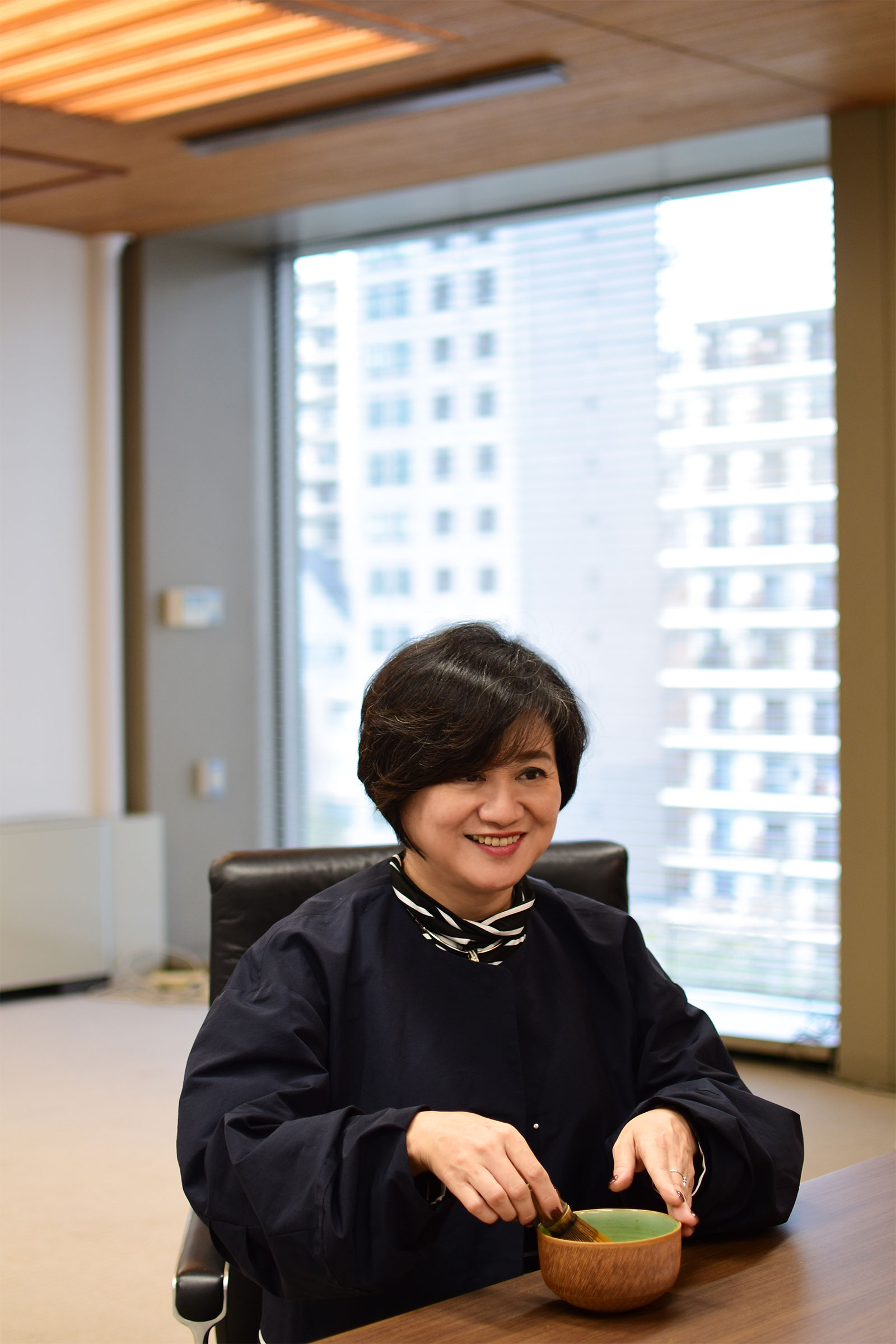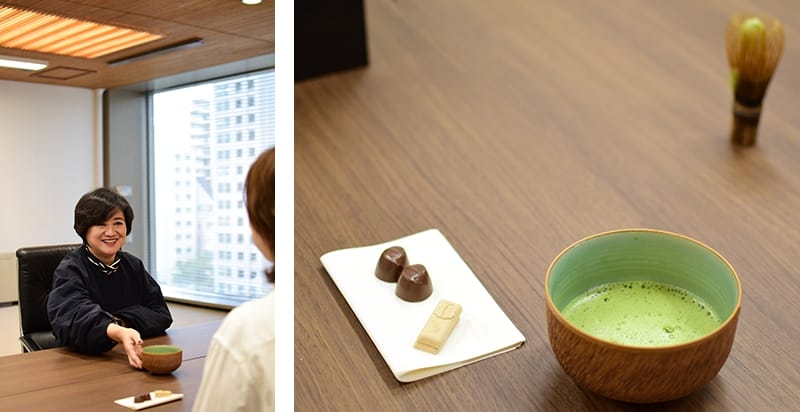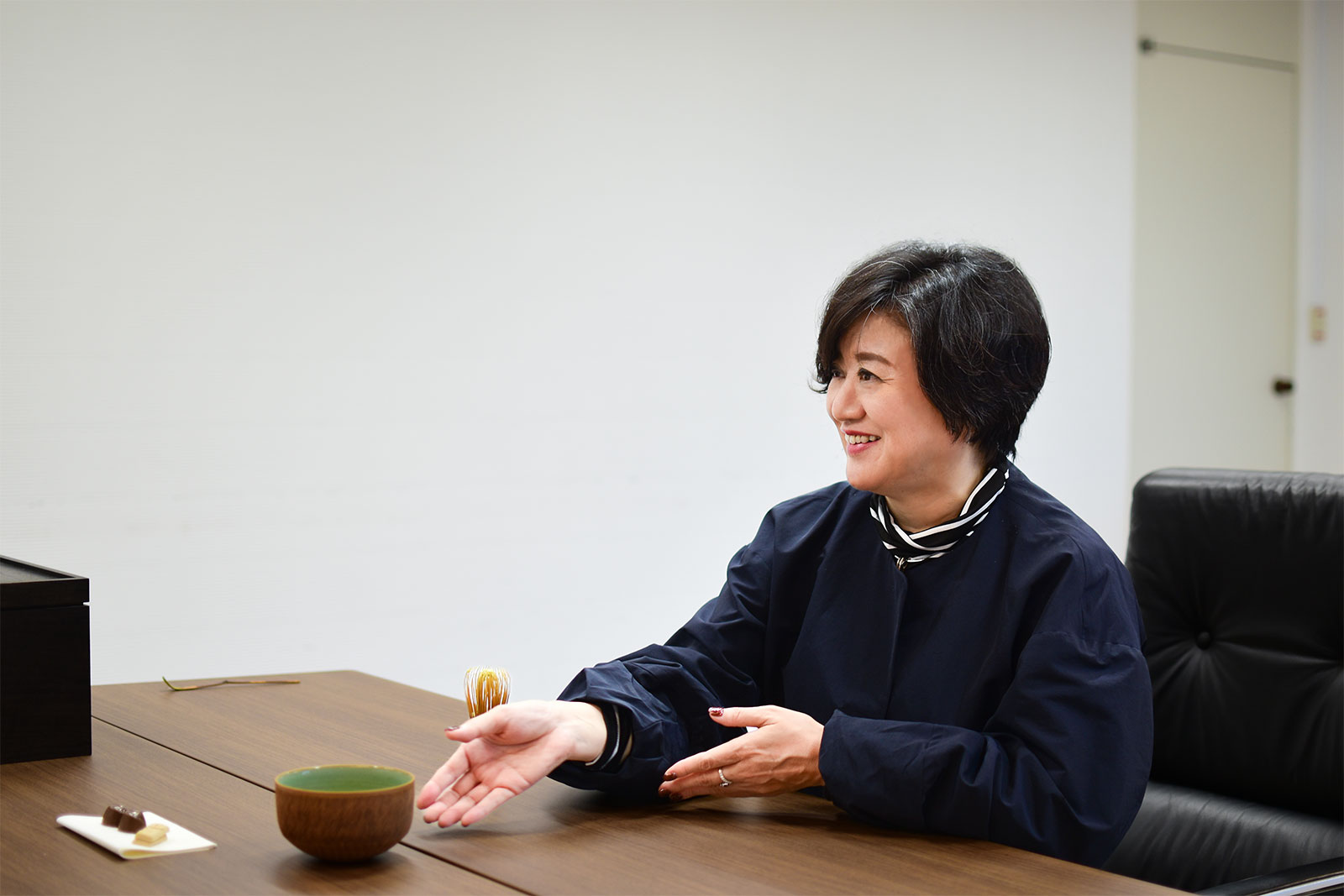- TOP
- Stories
- Interview with Pola President Miki Oikawa:The Never-Ending Journey of the Tea Ceremony「Facing your True Self」(5)
- Business Solution
Interview with Pola President Miki Oikawa:The Never-Ending Journey of the Tea Ceremony「Facing your True Self」(5)
![[Management Interview] Miki Oikawa, President of Paula](/nikkeiinfo/en/global_services/240306_nikkei_bp_thumb.jpg)
By: Yoh Otsuka (Senior Fellow & Senior Consultant, Intelligence Group, Nikkei Business Publications)
An increasing number of business executives are taking part in tea ceremony classes. What is it about the tea ceremony that attracts these busy people?
Miki Oikawa, CEO of Pola Inc., has been practicing tea ceremony (sado) for five years. She is a member of the urasenke school of the tea ceremony.
She started practicing in 2018, when she was in charge of overseas business at Pola. "When we talked about hospitality for foreign guests, I started to wonder about my own behavior as a Japanese person and whether I had properly mastered correct manners," says Oikawa.
Oikawa had experienced the tea ceremony when she was in her 20s. "I was working at the Saitama office, and the "grand owner," who was a woman in her 50s and led the organization, would practice tea ceremony. She would invite a tea ceremony teacher, and around half of a three-hour sales meeting would be used up teaching us how to prepare tea." At the time, Oikawa didn't feel she had time to spend on the tea ceremony. "Frankly, I wanted to talk about sales targets, not about making tea," she said. She had talked with her colleagues about how tasty the sweets were, but had not felt any connection to the spirit of the tea ceremony. But the grand owner would say: "The tea ceremony is essential for the future of leadership. Those who lead people's hearts and minds need to have space inside themselves."
25 years later, in 2018, the grand owner's words came back to Oikawa. "The job of Pola's sales staff is to be close to the hearts of our customers. I finally understood what the grand owner meant. Through the tea ceremony, leaders can cultivate a range of perspectives that help our sales staff to grow and develop." At around the same time, an old friend happened to visit Oikawa's home. She was dressed in kimono, and said that there was a tea ceremony event in the neighborhood. She introduced Oikawa to the teacher and Oikawa started practicing tea ceremony again, at the age of 49.
Practicing gives a sense of totonou (refreshing and resetting)
The charm of the tea ceremony," says Oikawa, "is not only the delicious matcha tea, but also that it refreshes and detoxifies the mind and the body." She now aims to practice twice a month despite her extremely busy work as president of the company. "When I practice in the morning air in the tearoom, I feel refreshed," she says. "It is similar to the totonou feeling one gets from a sauna. And when I listen to the explanation of a hanging scroll in the tokonoma (alcove) and it perfectly matches my feelings that day, it's a 'you got me!' moment."
In the tea ceremony, the utensils change with the season. Tea bowls may be decorated with cherry blossoms in spring, or autumn leaves in fall. The bowls are shallow in summer and deep in winter, and the way to handle them depends on their shape. In addition, there are three grades of serving tea: shin, gyo and so, meaning formal, semi-formal, and informal, respectively. In the so style, the utensils are handled with the right hand, while in the shin style, the utensils are sometimes handled with the left hand. Counting the combinations of serving styles and utensils, there are probably hundreds of different variations of the tea ceremony. This is why the tea ceremony is said to be complicated and difficult to master.
That, too, is interesting to Oikawa. "As the seasons change and the utensils change, we need to be more flexible," she said. "The variable nature of the tea ceremony is like 'diversity without boundaries,' which is what makes it interesting." Oikawa points out that this is similar to the business world. "There are theories in business, but society and people's attitudes change with the times. It is necessary to adapt to the situation without relying on set rules or past successes," she says.

Tea bowls, tea whisks, and other utensils are kept in the president's office
Rules of conduct are a "common language" of both the host and the guests
Oikawa's tea master often organizes tea ceremonies. "My master always says, 'The most important thing is to think about the feelings of the guests who come to the tea ceremony. Think how they will enjoy the tea ceremony and how they will feel when they leave, and choose the tea utensils and decorations accordingly. This preparation time should be enjoyed wholeheartedly'. Hearing this, I felt I understood what true hospitality is all about," said Oikawa.
The tea ceremony has detailed rules of etiquette, such as the way to walk on the tatami mats and the way to bow. The tea ceremony has a number of rules and Oikawa points out that it may be a good thing that there are certain common rules. The master of the tea ceremony can enjoy the ceremony with his/her guests based on that common language, while offering hospitality that is uniquely his/her own.
There is a term that describes the stages of training: shuhari. Shu means "faithfully follow and master the basic style," ha means "break the style and develop it," and ri means "depart from the basics and express one's individuality". It may mean learning the basic style first, and then demonstrating one's own originality. Learning things this way over a long time could indeed contribute to reskilling.
Oikawa says, "The good thing about practicing is that I have the opportunity to be taught. When one reaches my age, you are rarely scolded by someone. There are times when I don't do well in serving tea and nothing seems to go well," she says. But Oikawa believes that even in her mid-50s, this kind of experience is necessary for self-improvement.

Making and serving tea to retiring employees who come to bid farewell
The tea ceremony is for each person to enjoy in his/her way
"Fortunately, my master is a wonderful person, and everyone in the school is very pleasant," says Oikawa. The students are dressed in a variety of styles: women in kimono, men wearing hakama, some wearing practice aprons over Western-style clothes, and some just wrapping on a belt to hold the fukusa silk cloth used for wiping utensils. "I think that people should enjoy the tea ceremony in different ways," says Oikawa.
With the number of people practicing the tea ceremony declining, what can be done to attract more people, especially businesspeople? "We should increase the number of opportunities for people to casually experience the tea ceremony. Many people have had powdered green tea at sweet shops and other places, but I don't think they have had the opportunity to make tea themselves," says Oikawa. Rules are important, but it is also necessary to prepare a place where people can participate freely. It would be a good idea to increase the number of practicing places where table-style tea ceremonies can be held and people can practice tea ceremony in Western-style dress.
In order for businesspeople to be active on the global stage, they must first learn about Japan. By learning the tea ceremony, Oikawa says, we can reaffirm our Japanese way of thinking and feeling.
"The tea ceremony may seem formal, but it also has a flexible aspect. The grand owner I mentioned earlier once said to me, 'You have to understand it with your own body, not with words,' and I have come to understand what she meant. For me, the tea ceremony is a 'journey without end'. I would like to continue my practice while facing my true self," says Oikawa.

Oikawa recommends sweets and tea(She is wearing a ring because this was during business hours and not practice time)
Miki Oikawa, CEO of Pola Inc.
Oikawa joined Pola in 1991. After serving as Area Manager in Saitama and General Manager of the Product Planning Department, she was appointed Executive Officer in 2012 and Director in 2014. She assumed her current position as CEO in January 2020. She leads purpose-based management and diversity management with the mission of creating a society where everyone can develop his/her own potential. Author of "Happy Teams Get Results" (co-author, Nikkei Business Publications)
For further details, please contact:
Nikkei Business Publications, Inc.
NIKKEI BP

"Foresee the future, Unlock the insight" is the expression that describes our mission. As Japan's leading BtoB media service, we meet diverse business community needs in the three key categories of "management," "technology" and "lifestyle."
See More
